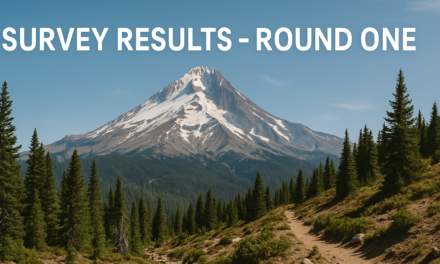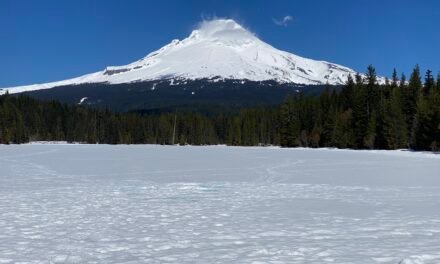This is the second part of the 2023 Timberline Trail Survey raw results. To see the first set of results please see here. This continues the raw data sets from the 2023 survey. Again the entire survey will be presented in three parts. (Note that some of the formatting will change from last year – in between providing the survey updates – I changed from a PC to a Mac and also swapped from using Excel to Numbers).
How would you rate the difficulty of traverses?

Last year I only listed three traverses and so this year’s survey has an expanded list of traverses. Unfortunately, I wish I had added other traverses to the list. No surprise in that the Eliot was ranked the hardest traverse. This year it was very much a scramble and often needed a rope assist. Interesting folks seemed to think traverse generally got a little tougher in the clockwise direction. This maybe a result of more folks going clockwise than counter clockwise and being a little tired at the end of the loop.
However I’d generally rank the Zigzag and Sandy canyon traverses as being fairly easy, although if you are going counter clockwise it is a pretty long slog from the Sandy back up to Timberline lodge.
Which of the following was an issue for you?

This was a pretty broad category of questions that explored which typical hiking issues were an issue. This covered everything that was not medical related, from weather to animals, to hiking buddies. The good news is the vast majority of hikers had a pleasant hike with very few issues. This year the summer was very favorable for hiking.
Although there were not many issues reported – the biggest issue this year was navigation, beating out mosquitoes from last year. Wind and rain were an issue for some folks – and when they occurred were more severe an issue – I assume this is related to a few specific days.
Although there were a few issues reported as being major; they broke down as Wind(4), Rain(4), Snow(3), Smoke(3), Other Dogs (3), Members in my group (1), Navigation(1), Members in my group(1) and Hikers not in my group (1).
I’m glad to see that issues with dogs remain few. The trail and Mount Hood National Forest are very dog friendly and it seems that the majority of interactions with dogs are not an issue.
What kind of shoes did you wear?

Back to the simple stuff. There has been a general trend for lighter footwear in the hiking community. This is echoed by the results from the survey where almost 70% of the hikers are now hiking in trail runners and under a 1/4 in traditional hiking boots. This is a slight change from last year where about 63% were in trail runners. As more hikers are using trail runners it seems that this is at the expense of traditional hiking boots.
Did you take trekking poles?

No real surprise that most people are taking two trekking poles. These provide good stability and are almost essential for a longer hike. There are a few people who hike with a single pole (and I often will) but this might be because only one hand is free and the other is used, for example, to hold onto a dog leash. And a few folks are hiking without poles. Overall there were more folks taking trekking poles this year and last year with an increase from 87% to over 95%.
Did you take crampons? / Did you take microspikes?

These two questions are related to snow preparedness. There was quite a lot of snow on the trail in the early season. Despite this, no one took crampons with them. There were a few people who took micro-spikes. Overall more people took micro-spikes this year than last year. With just under 10% of hikers taking spikes with them. There were some early concerns on snow conditions and this presumably lead to the increase. The good news is that information about the trail is freely available and so as soon as it is completely snow free, I assume no-one takes spikes with them from that point.
There were a couple of very hardy early hikers this year – maybe they did not complete the survey as I am pretty sure they would have had crampons with them – one summited Mt. Hood sand then completed the trail.
Did you take bear spray?

It’s pretty much said that the black bears on Mount Hood are timid and will avoid you. In all the years I have been hiking on the mountain I have yet to see a bear on a hike. I have seen evidence of bears and seen a couple down in Rhododendron – but not on the mountain itself. For most folks carrying bear spray is considered unnecessary.
Last year around 8% carried bear spray. This year the number dropped to less than 5%. Maybe the message is getting out and it’s just unnecessary. There may be a possibility that some hikers are bringing bear spray as general protection – that might be a correlation to look at later. However, it’s worth noting from the above, that only one person noted an issue with a bear and this was mild.
What food storage method did you use?

Related to bringing bear spray is how you hang your food. Again generally hangs are considered more of a critter hang than a bear hang – although there are clearly bears around the trail and so taking more a precaution with food to prevent it from being pilfered by bears would be advisable.
This year there was an increase in hikers using bear canisters: rising from about 10% to around 17%. And about a 5% increase in those using bear bags. However, the majority of hikers are just hanging their food. However, a good clarification would be a bear hang versus just a critter hang. I meant to add this as a clarity to the question this year!
Navigation Support

Possibly the most surprising result from the entire survey continues to be navigation support. Map and compass have always been part of the 10 essentials. Although there are additional great navigation aids available, with phones and GPS devices, having a map and compass (and being able to use them) is always advisable as a backup. And when everything goes well, the Timberline Trail is not hard to follow, I was surprised by the lack of a map and compass with many hikers.
These results are almost identical to last years with cell phones being the predominate favored navigation device and compasses being only carried by a relative few. I’ve recently seen a few hiker debates that have said modern hikers have only grown up with digital navigation and it makes no sense to bring a compass. Not sure I’m 100% on-board with that argument. The number of times I hear SAR saying that a situation could have been avoided if the hiker had a map/compass still seems to warrant carrying them.
Who is your cell carrier?

Cell coverage is improving around Mount Hood. There are many places that have excellent coverage around the ski resorts and also in the line of sight of some of the towns. This question will need a little more analysis, in particular, which carriers provide the better service.
Verizon dropped about 7% points over last year. With the increase going to both T-Mobile and Other. AT&T stayed about the same. The three big carriers that also have their own independent networks. Anyone who is in the other ‘other’ category is most likely using service provided by one of the major three carriers.

In terms of coverage, the distribution looks almost exactly the same as last year. The majority of hikers found that they had coverage for around 1/3rd of the hike, although there were some that considered themselves to have coverage over 2/3rds of the time. I’ll look at breaking this down by carrier in the future so that we can see which of the carriers provides the best service around the whole of the Timberline Trail.
Also as technology improves there are a number of new developments that might make communication easier. Historically satellite communications had been only in the realm of such devices as Garmin’s. However, recently Apple announced that their new series of iPhones will be enabled with satellite communication for emergencies and no doubt as this technology improves it will slowly include more ways of communicating.
There’s still more raw data to analyze in the 2023 Timberline Trail Survey, so I’ll be including a final series with the rest of the raw data from the second annual Timberline Trail survey results.
Part three of the results are here.






Trackbacks/Pingbacks